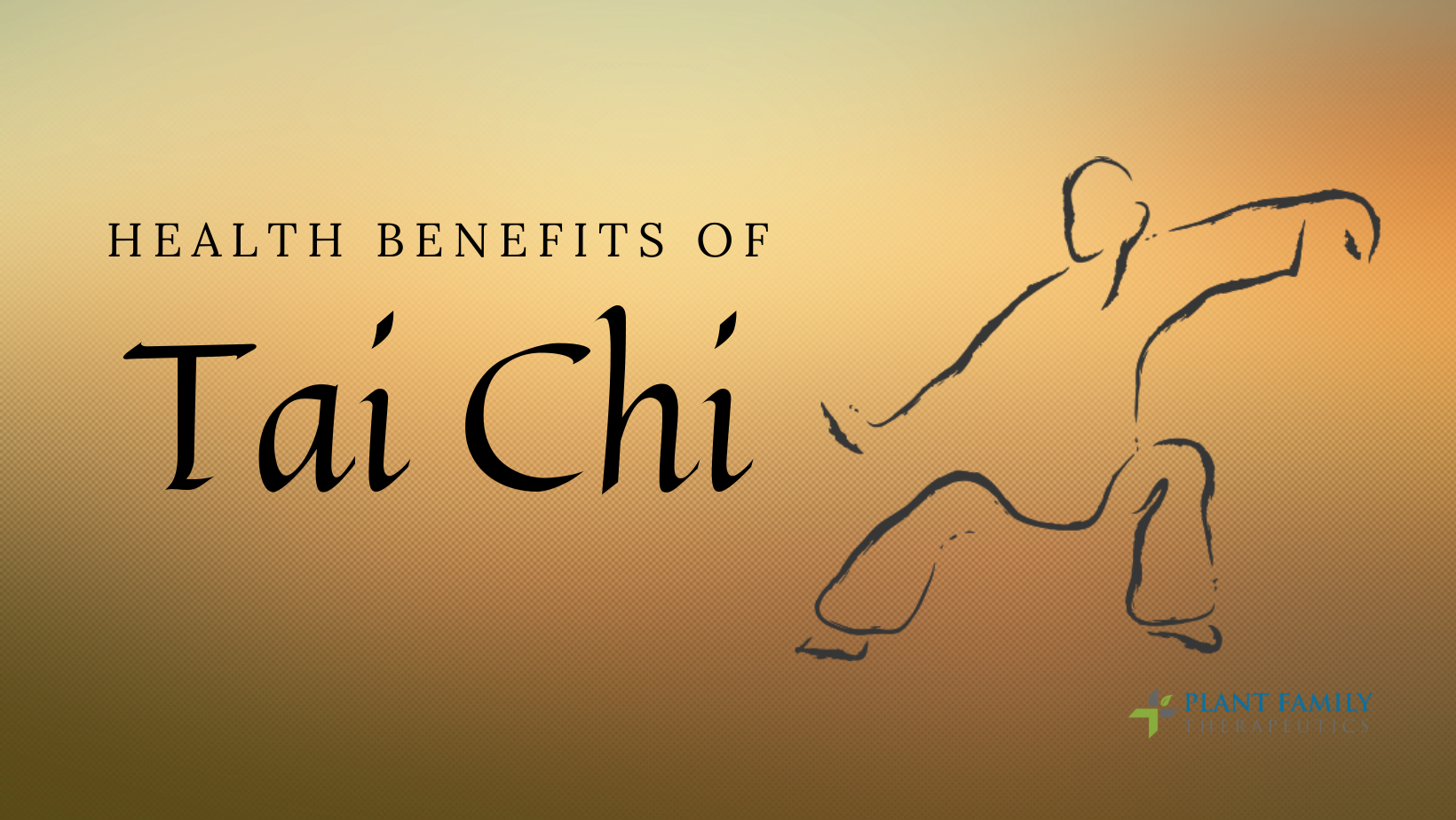
April 20, 2021 – By Sandy Yanez
What is Tai Chi?
Tai Chi is an ancient Chinese tradition, originally developed for self-defense, which has become popular as a mainstream exercise, usually practiced in slow motion to improve health. Research has shown that tai chi practice can improve our body coordination, improve balance, and reduce risks for falls, especially for seniors. Tai chi practice can also help to reduce anxiety, depression, and stress.
When practicing tai chi, you are focused on deep breathing, good balance, and mind/body coordination of movements. As a result, regular tai chi practice can result in calmness, inner awareness, and stillness. As a beginner to tai chi, it is important to understand the differences of each style and choose the one that most fits your interest and condition. There are several styles of tai chi widely practiced in the world. In this article, I will be speaking about four of them – Chen style, Yang style, Sun style, and Wu style.
The two most important styles are often considered to be the Chen style and the Yang style. The Chen style was the original style that gave rise directly or indirectly to all other styles. The Yang style is the most practiced type in both China and the world today.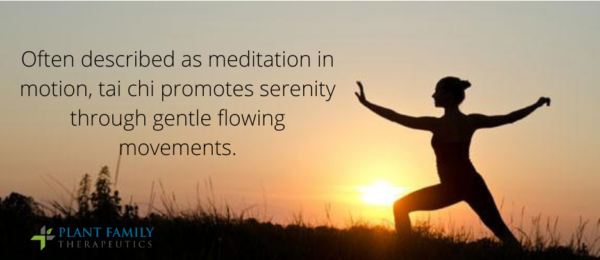
Choosing the appropriate tai chi style is one of the most important decisions you will make once you decide to practice. Most beginners think of tai chi as just one art form and don’t realize the multitude of styles available. Even if you’re already practicing a certain style, it helps to know the differences because, at some point, you may also benefit greatly from learning another style.
Styles of Tai Chi:
Chen Style – slow, graceful movements are alternated with quick, forceful ones. Chen style tai chi provides a good cardio workout and rebuilds body systems and balance. It demands more physical coordination and may strain the lower back and knees more than other styles. The complexity of its movements, which include fast releases combined with jumping kicks and stamping actions, makes it more athletic and physically difficult than most other tai chi styles.
Yang Style – is the second tai chi style developed after the original Chen family style. The explosive power, jumps, and foot stomps were removed. In its place, there is more emphasis on maintaining a large frame combined with a series of expansive opening and closing movements. The Yang style is the most popular, and it consists of slow continuous, soft, and circular movements in a flowing form. Each posture flows into the next without pausing.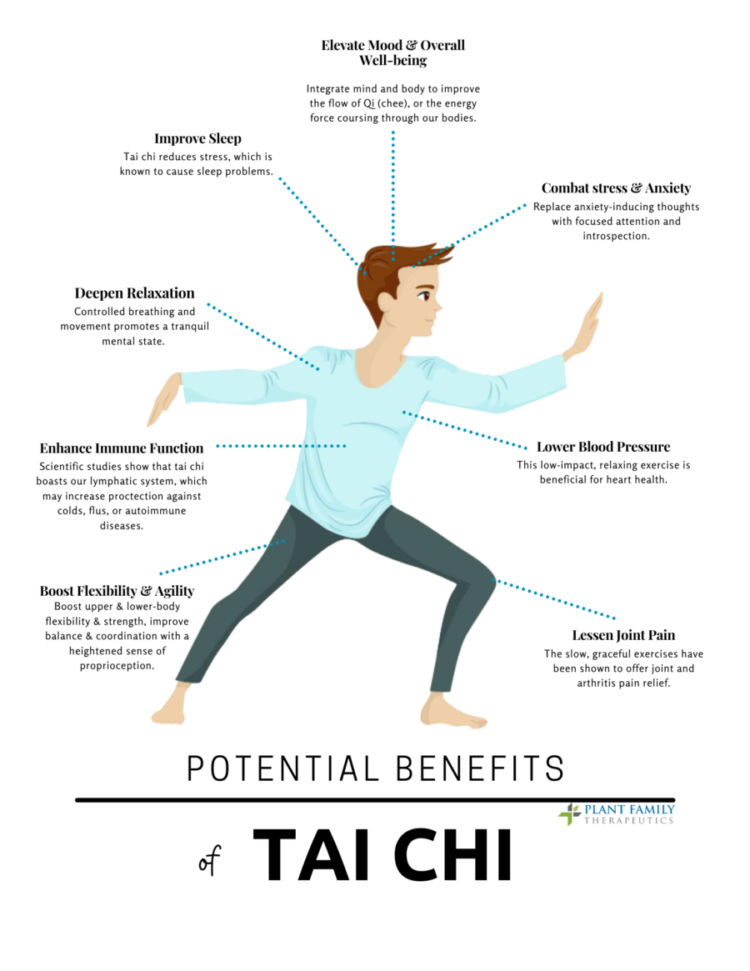
Sun Style – is the gentlest of all styles and is characterized by one foot following the other – “Follow Steps.” There is a clearly defined transference of weight between substantial and insubstantial steps. Sun Style has a higher stance, less kicking and punching, all movements have the same tempi, and a very strong Qigong emphasis making it more popular with older practitioners. Follow-steps provide balance, agility and flexibility; while lively steps are beneficial to health, especially for prevention and improving mobility problems.
Wu Style – the footwork is parallel and, like Yang, utilizes a horse-stance. The feet remain positioned relatively close to one another, the stance is higher, and steps are shorter than steps in Yang or Chen Styles. In fact, Wu has much less external motion than other styles. Its motions are compact, and its hand techniques are typically limited to small circles. The key characteristic of Wu style tai chi, which everyone notices, is the posture of the style. The unique movement of leaning forward and tilting back requires good core strength to hold the body straight but leaning.
Why try tai chi?
When learned correctly and performed regularly, tai chi can be a positive part of an overall approach to improving your health. There is a large body of research that suggest that tai chi practice is beneficial for:
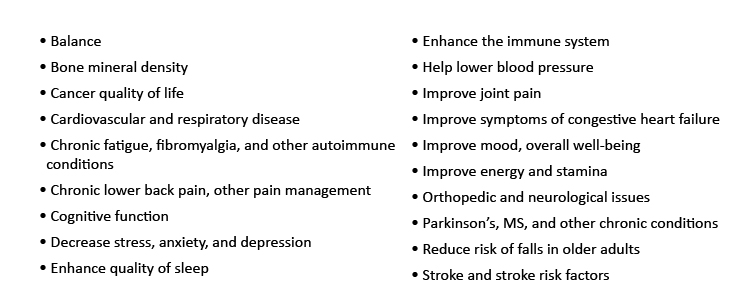
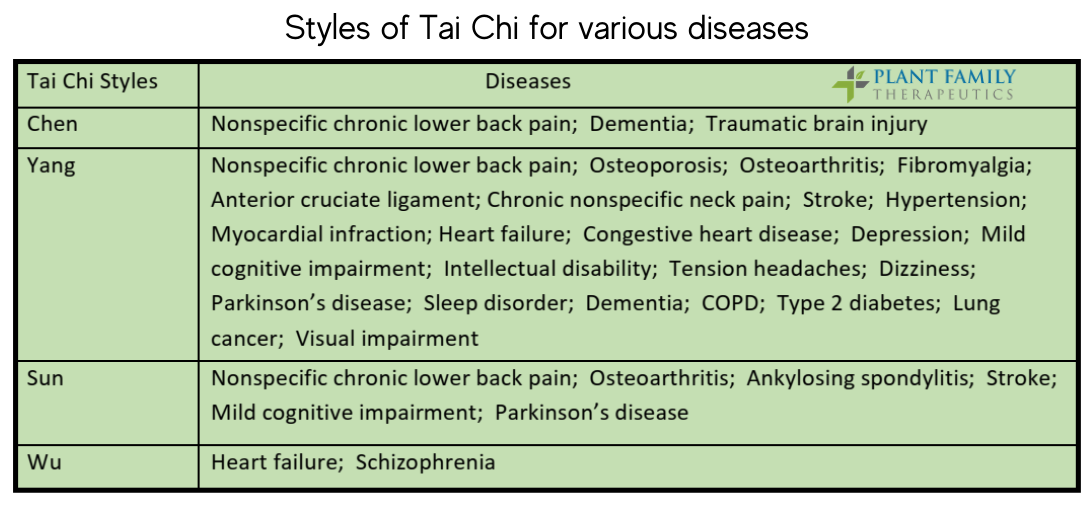
Cautions
Tai Chi uniquely fuses physical exercise with meditation. This rare combination provides numerous benefits to both your physical and mental health, and because of the slow and steady movements it’s accessible to almost everyone who’s interested in learning and practicing the art.
Even though tai chi is considered one of the safer forms of physical fitness, it’s still a good idea to talk with your doctor before trying something new, especially if you have any existing medical conditions.
The bottom line
Practicing tai chi can improve both your physical and mental health. This safe and gentle form of exercise is appropriate for all ages and fitness levels. Plus, it is easily adaptable to certain physical limitations and health conditions.
To get started, look for tai chi classes taught by experienced instructors at senior centers, health clubs, and fitness studios.
References:
Bystritsky, A., Hovav, S., Sherbourne, C., Stein, M. B., Rose, R. D., Campbell-Sills, L., Golinelli, D., Sullivan, G., Craske, M. G., & Roy-Byrne, P. P. (2012). Use of complementary and alternative medicine in a large sample of anxiety patients. Psychosomatics, 53(3), 266–272. https://doi.org/10.1016/j.psym.2011.11.009
Chao, M., Wang, C., Dong, X., & Ding, M. (2018). The Effects of Tai Chi on Type 2 Diabetes Mellitus: A Meta-Analysis. Journal of diabetes research, 2018, 7350567. https://doi.org/10.1155/2018/7350567
Ho, R. T., Au Yeung, F. S., Lo, P. H., Law, K. Y., Wong, K. O., Cheung, I. K., & Ng, S. M. (2012). Tai-chi for residential patients with schizophrenia on movement coordination, negative symptoms, and functioning: a pilot randomized controlled trial. Evidence-based complementary and alternative medicine : eCAM, 2012, 923925. https://doi.org/10.1155/2012/923925
Huang, J., Wang, D., & Wang, J. (2021). Clinical Evidence of Tai Chi Exercise Prescriptions: A Systematic Review, Evidence-Based Complementary and Alternative Medicine, vol. 2021, Article ID 5558805, 14 pages https://doi.org/10.1155/2021/5558805
Huang, Y., & Liu, X. (2015). Improvement of balance control ability and flexibility in the elderly Tai Chi Chuan (TCC) practitioners: a systematic review and meta-analysis. Archives of gerontology and geriatrics, 60(2), 233–238. https://doi.org/10.1016/j.archger.2014.10.016
Lan, C., Chen, S. Y., Lai, J. S., & Wong, A. M. (2013). Tai chi chuan in medicine and health promotion. Evidence-based complementary and alternative medicine : eCAM, 2013, 502131. https://doi.org/10.1155/2013/502131
Lim, K. H., Pysklywec, A., Plante, M., & Demers, L. (2019). The effectiveness of Tai Chi for short-term cognitive function improvement in the early stages of dementia in the elderly: a systematic literature review. Clinical interventions in aging, 14, 827–839. https://doi.org/10.2147/CIA.S202055
Ma, C., Zhou, W., Tang, Q., & Huang, S. (2018). The impact of group-based Tai chi on health-status outcomes among community-dwelling older adults with hypertension. Heart & lung : the journal of critical care, 47(4), 337–344. https://doi.org/10.1016/j.hrtlng.2018.04.007
Phang, J. K., Kwan, Y. H., Goh, H., Tan, V., Thumboo, J., Østbye, T., & Fong, W. (2018). Complementary and alternative medicine for rheumatic diseases: A systematic review of randomized controlled trials. Complementary therapies in medicine, 37, 143–157. https://doi.org/10.1016/j.ctim.2018.03.003
Raman, G., Zhang, Y., Minichiello, V. J., D’Ambrosio, C. M., & Wang, C. (2013). Tai Chi Improves Sleep Quality in Healthy Adults and Patients with Chronic Conditions: A Systematic Review and Meta-analysis. Journal of sleep disorders & therapy, 2(6), 141. https://doi.org/10.4172/2167-0277.1000141
Reid-Arndt S., Matsuda S., & Cox R,. (2011). Tai Chi effects on neuropsychological, emotional, and physical functioning following cancer treatment: A pilot study, Complementary Therapies in Clinical Practice doi:10.1016/j.ctcp.2011.02.005
Salmoirago-Blotcher, E., Wayne, P. M., Dunsiger, S., Krol, J., Breault, C., Bock, B. C., Wu, W. C., & Yeh, G. Y. (2017). Tai Chi is a promising exercise option for patients with coronary heart disease declining cardiac rehabilitation. Journal of the American Heart Association, 6(10), e006603. https://doi.org/10.1161/JAHA.117.006603
Tsai, P. F., Kitch, S., Chang, J. Y., James, G. A., Dubbert, P., Roca, J. V., & Powers, C. H. (2018). Tai Chi for posttraumatic stress disorder and chronic musculoskeletal pain: A Pilot Study. Journal of holistic nursing, 36(2), 147–158. https://doi.org/10.1177/0898010117697617
Wang C. (2011). Tai chi and rheumatic diseases. Rheumatic diseases clinics of North America, 37(1), 19–32. https://doi.org/10.1016/j.rdc.2010.11.002
Wang C, Schmid CH, Rones R, et al. (2010). A randomized trial of tai chi for fibromyalgia. N Engl J Med, 363,743-754. doi: 10.1056/NEJMoa0912611
Wang, C., Bannuru, R., Ramel, J., Kupelnick, B., Scott, T., & Schmid, C. H. (2010). Tai Chi on psychological well-being: systematic review and meta-analysis. BMC complementary and alternative medicine, 10, 23. https://doi.org/10.1186/1472-6882-10-23
Wu, W., Liu, X., Wang, L., Wang, Z., Hu, J., & Yan, J. (2014). Effects of Tai Chi on exercise capacity and health-related quality of life in patients with chronic obstructive pulmonary disease: a systematic review and meta-analysis. International journal of chronic obstructive pulmonary disease, 9, 1253–1263. https://doi.org/10.2147/COPD.S70862
Yan, J. H., Gu, W. J., Sun, J., Zhang, W. X., Li, B. W., & Pan, L. (2013). Efficacy of Tai Chi on pain, stiffness and function in patients with osteoarthritis: a meta-analysis. PloS one, 8(4), e61672. https://doi.org/10.1371/journal.pone.0061672
Yu, X., Wu, X., Hou, G., Han, P., Jiang, L., & Guo, Q. (2021). The Impact of Tai Chi on Motor Function, Balance, and Quality of Life in Parkinson’s Disease: A Systematic Review and Meta-Analysis. Evidence-based complementary and alternative medicine : eCAM, 2021, 6637612. https://doi.org/10.1155/2021/6637612
Zou, L., Wang, C., Chen, K., Shu, Y., Chen, X., Luo, L., & Zhao, X. (2017). The effect of tai chi practice on attenuating bone mineral density loss: A systematic review and meta-analysis of randomized controlled trials. International journal of environmental research and public health, 14(9), 1000. https://doi.org/10.3390/ijerph14091000